

Melovin: 10 facts about Ukraine's Eurovision 2018 singer. Melovin will bring the heat — and his fiery Vidbir 2018 staging — to Eurovision 2018 for Ukraine.

Singing the dramatic and pop-tastic tune “Under the Ladder”, he’s hoping to take Eurovision back to Ukraine for the second time in three years. Producers have set the running order for the semi-finals and Melovin will perform last. It’s a telling decision that suggests organisers have faith he’s worthy of closing the show — and will keep people interested as the semi moves into the voting segment.
Happy Birthday song in Ukrainian sung by Nat. Traditional Ukrainian songs and music. Traditional Ukrainian songs are famous all over the world.
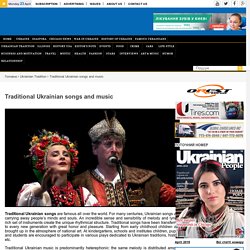
For many centuries, Ukrainian songs are carrying away people’s minds and souls. An incredible sense and sensibility of melody and lyrics, rich set of instruments create the unique rhythmical structure. Traditional songs have been transferred to every new generation with great honor and pleasure. Traditional Music and Instruments from the Ukraine - text in English. The principle of heterophony allows the principal voice much space for improvisation, continuous variation, and embellishment.

It has also an effect on the lyrics, in so far as single words or phrases are lengthened by means of vocalisms or enlarged with additional syllables. This type of choral singing can frequently be found in Central Ukraine, in the steppes and in Eastern Ukraine, where also lyrical ballads are very popular. The rather comprehensive repertory of Cossack songs and dances has become very famous. This music has its roots in a centuries old oral tradition of bylina (epics, heroic narrative poetry) and dumas, that is long lyrical ballads glorifying the exploits of the Cossacks. Traditional folk music is the Ukrainians' life and soul. Klezmer: Definition, Music & Instruments.
Klezmer Early Yiddish Instrumental Music 1908 1927. What is Klezmer Music? What is Klezmer Music?

By Becky Weitzman Klezmer (klez´mær) n. 1 pl. klez´mor·im´ (-mæ reem´) a) [Historical] an itinerant musician who performed at Jewish weddings and holiday celebrations in Eastern Europe b) a musician who performs instrumental Jewish folk music derived from Eastern European folk songs, Hebrew melodies, etc. 2 this instrumental folk musicfrom Webster's NewWorld Dictionary. What is "Klezmer Music"? What is "Klezmer Music"?
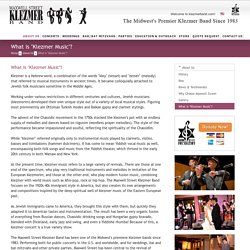
Klezmer is a Hebrew word, a combination of the words "kley" (vessel) and "zemer" (melody) that referred to musical instruments in ancient times. It became colloquially attached to Jewish folk musicians sometime in the Middle Ages. Working under various restrictions in different centuries and cultures, Jewish musicians (klezmorim) developed their own unique style out of a variety of local musical styles. Figuring most prominently are Ottoman Turkish modes and Balkan gypsy and clarinet stylings.
Top 10 Best Indonesian Singers. 1Agnes Monica Yes.

She is just number 1 diva in Indonesia. She has everything that someone need to be a diva.. Indonesian Traditional Musical Instruments – Wandering Bakya. Cultural Center of the Philippines (CCP) has an extensive collection of Asian traditional musical instruments.
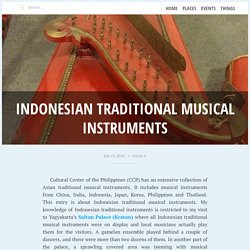
It includes musical instruments from China, India, Indonesia, Japan, Korea, Philippines and Thailand. This entry is about Indonesian traditional musical instruments. My knowledge of Indonesian traditional instruments is restricted to my visit to Yogyakarta’s Sultan Palace (Kraton) where all Indonesian traditional musical instruments were on display and local musicians actually play them for the visitors. Wayan Loceng - Indonesian Traditional Music. Official website of Dee Lestari. Japanese Music: Top Japanese Songs Chart. Traditional Japanese Music. Traditional Japanese Music. There are several types of traditional, Japanese music (hogaku).
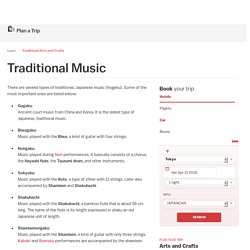
Some of the most important ones are listed below: Gagaku: Ancient court music from China and Korea. It is the oldest type of Japanese, traditional music. About Japanese Music. The earliest forms of music were drums and flute music accompanying the kagura shrine dances.
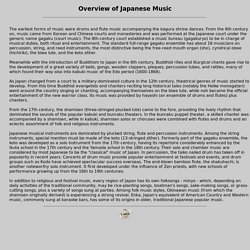
From the 6th century on, music came from Korean and Chinese courts and monasteries and was performed at the Japanese court under the generic name gagaku (court music). The 8th-century court established a music bureau (gagakuryo) to be in charge of musical duties, both ritual and entertainment. The standard full-range gagaku ensemble has about 16 musicians on percussion, string, and reed instruments, the most distinctive being the free-reed mouth organ (sho), cyndrical oboe (hichiriki), the biwa lute, and the koto zither. Meanwhile with the introduction of Buddhism to Japan in the 6th century, Buddhist rites and liturgical chants gave rise to the development of a great variety of bells, gongs, wooden clappers, plaques, percussion tubes, and rattles, many of which found their way also into kabuki music of the Edo period (1600-1868).
Celtic Music Instruments. From the thump of the Bodhrán to the airy rasp of the wooden flute, celtic music is known by its instruments.
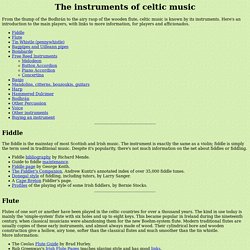
Here's an introduction to the main players, with links to more information, for players and afficionados. Fiddle The fiddle is the mainstay of most Scottish and Irish music. The instrument is exactly the same as a violin; fiddle is simply the term used in traditional music. Irish singers - The world's best singers of Irish folk music. Ancient Celtic Folk Song (In Gaelic) Lyric Translation in description. Irish Fiddle : Mairead Ni Mhaonaigh. African music compilation - 38 minutes of african melodies. Music of Africa.
Women from the Masai tribe, singing. The music of Africa is as vast and varied as the continent's many regions, nations, and ethnic groups. The African continent comprises approximately 20 percent of the world's land mass and has a population of roughly 934 million. African music is as diverse as its cultures and peoples and has flowered in many indigenous forms as well as been shaped by foreign influences.
Although there are many different varieties of music in Africa, there are a number of common elements to the music, especially within regions. The concept of music in Africa, especially in sub-Saharan Africa bears a difference from other regions and cultures. 10 Most Popular African Musical Instruments. When it comes to musical instruments, the African continent is well-known for its vast instruments. There are very many tribes or ethnic communities in Africa. Each tribe will have its own unique instruments. This has led to very many types of instruments which comprises of wind, stringed and also percussion.
The following is a list of the 10 most popular African musical instruments, here goes the list. Sampa The Great. November 1930 Memphis CANNON'S JUG STOMPERS "WOLF RIVER BLUES" Jug Band Music Festival in Louisville. Jug Band Music Part 1. Articles From The Press - National Jug Band Jubilee. Oldest Native American drumming video ever. Native American Round Dance Music. Wampanoag Nation Singers and Dancers - Opening Ceremony. Article about Native American music by The Free Dictionary.
Barbara Jones Sad Movies. One hour of Reggae Roots songs. Back In The Day Oldies. Reggae. Reggae, style of popular music that originated in Jamaica in the late 1960s and quickly emerged as the country’s dominant music. By the 1970s it had become an international style that was particularly popular in Britain, the United States, and Africa. It was widely perceived as a voice of the oppressed. According to an early definition in The Dictionary of Jamaican English (1980), reggae is based on ska, an earlier form of Jamaican popular music, and employs a heavy four-beat rhythm driven by drums, bass guitar, electric guitar, and the “scraper,” a corrugated stick that is rubbed by a plain stick.
(The drum and bass became the foundation of a new instrumental music, dub.) Ahora Si - Ray Barretto. Fania Salsa (2 Hard Songs) - Bobby Valentin. Ibrahim ferrer. Explore the Music. Born in New York City in the 1960s and 70s, Salsa is a hybrid of traditional rhythms from Cuba (Son ) and Puerto Rico (Bomba y Plena ), with influences from Jazz and R&B. Primarily a dance genre, it is characterized by syncopated arrangements in clave rhythm, Spanish lyrics, and a strong rhythmic pulse punctuated by the trumpet or trombone. The word "Salsa" was used as an umbrella term for a variety of different existing rhythms and song styles (Guaracha, Son, Mambo to name a few), to help market the genre as a uniquely Latino music.
Fania Records was the biggest Salsa record label, and its artists were truly all-stars. By the late 70s, Salsa had grown far beyond New York, becoming the emblematic music for much of Latin America. Salsa also grew in political and social consciousness, but, in the 80s, sub-genres such as the smooth Salsa Romántica brought the genre great success in Latin America, but didn't appeal as much to young Latinos in New York. Sobbin' Blues - King Oliver's Creole Jazz Band. Original Dixieland Jass Band - Livery Stable Blues (1917) Early 1920's Jazz. The History of Jazz. The St. Louis Blues - early 1917 recording. First blues guitar recording. Skip James - Hard Time Killin' Floor Blues -HD. Blues. Blues, secular folk music created by African Americans in the early 20th century, originally in the South. The simple but expressive forms of the blues became by the 1960s one of the most important influences on the development of popular music throughout the United States.
Read More on This Topic jazz: Field hollers and funeral processions: forming the matrix …music; and, of course, the blues and ragtime. These last two forms began to flourish in the late 19th century—blues more as an informal music purveyed mostly by itinerant singers, guitarists, and pianists and ragtime becoming (by 1900) America’s popular entertainment and dance music. Ballads and Songs of the Blue Ridge Mountains. Sons of the Pioneers - Old Black Joe. Jean and edna ritchie sing four marys. Capital District Folk Music: What is Folk Music?